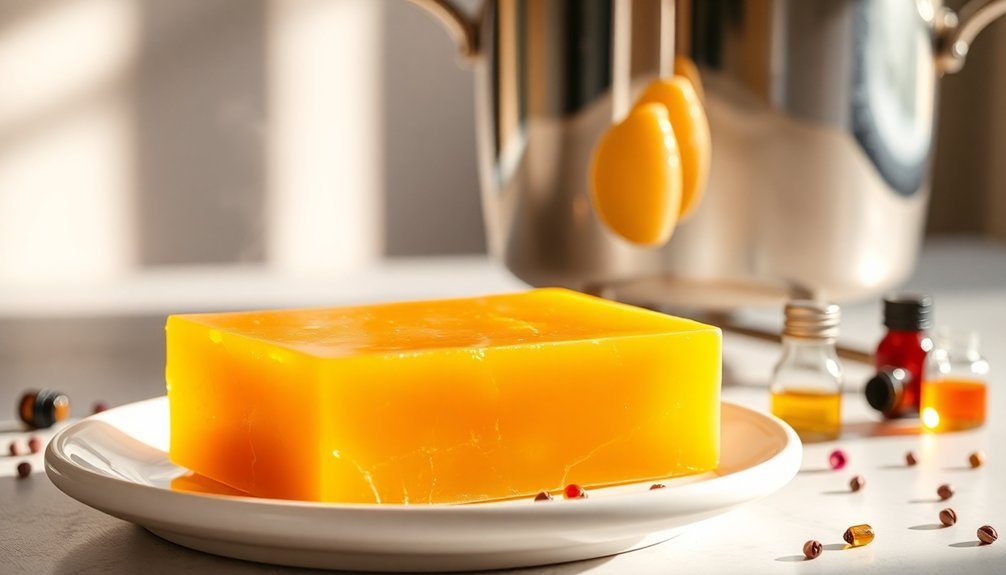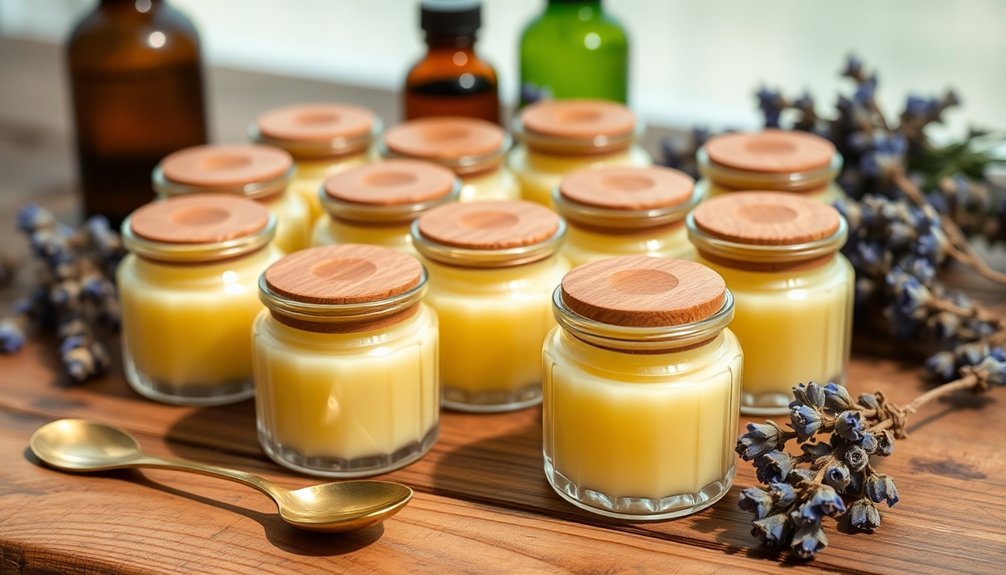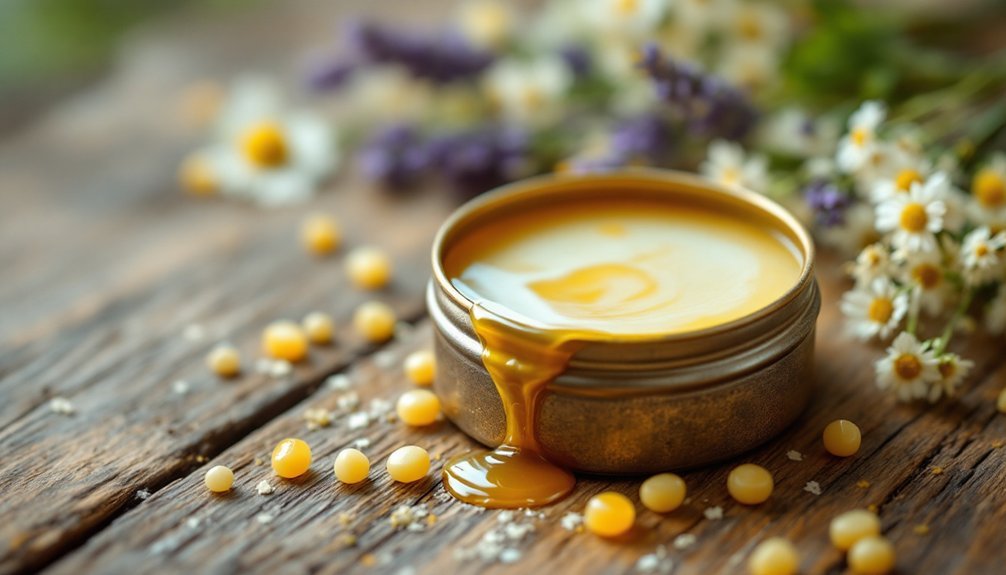Create your own natural solid perfume by gathering beeswax, carrier oil, and essential oils. Mix your chosen scents using the 30-50-20 ratio for top, middle, and base notes. Melt the beeswax with carrier oil in a double boiler, stirring continuously. Pour the warm mixture into small containers and let it cool completely. Store your perfume in a cool, dry place and apply to pulse points. These five simple steps will open your journey into custom fragrance creation.
Gathering Your Solid Perfume Making Supplies

Before diving into the creative process of making solid perfume, you'll need to gather specific supplies and ingredients to guarantee success.
Start by getting high-quality beeswax and your chosen carrier oil, such as sweet almond, jojoba, or grapeseed oil. You'll also need a double boiler or heat-safe bowl for safe melting. Using a low heat setting is essential for properly melting the ingredients.
Begin with quality beeswax and your preferred carrier oil – sweet almond, jojoba, or grapeseed. A double boiler ensures safe melting.
For precise measurements, grab a reliable scale to maintain the 1.5:0.5 ratio of oil to beeswax.
Don't forget containers for your final product – small sliding tins or lockets work perfectly. You'll need a spoon for stirring and a suction bulb for controlled pouring.
If you're looking to enhance your perfume, consider optional additions like shea butter for creaminess, mica powder for sparkle, or fragrance oils for scent variety.
Selecting and Blending Essential Oil Notes
Now that you've gathered your supplies, let's explore the art of blending fragrances for your solid perfume. Understanding the three types of notes – top, middle, and base – will help you create a balanced scent that evolves beautifully over time.
Follow the 30-50-20 rule for a harmonious blend: use 30% top notes (like bergamot or lemon), 50% middle notes (such as lavender or rose geranium), and 20% base notes (like sandalwood or vanilla). A well-blended perfume evolves gradually as you wear it throughout the day.
For a 10-drop blend, that's 3 drops of top notes, 5 drops of middle notes, and 2 drops of base notes. While this ratio serves as a starting point, you can adjust it to match your preferences.
Remember that top notes provide the initial burst of scent, middle notes form the heart, and base notes create lasting depth.
Melting and Mixing Your Beeswax Base

Creating your solid perfume base starts with carefully melting the beeswax in a double boiler over low to medium heat.
Keep your workspace clear and maintain a safe distance from flammable materials while you work.
Once your beeswax begins to melt, you'll need to add your chosen carrier oil. You can use almond, jojoba, grapeseed, or fractionated coconut oil in equal parts with the beeswax.
If you want a creamier texture, try adding some shea butter to the mixture.
Stir continuously to guarantee thorough blending and prevent separation. If your mixture becomes too thick, simply add more carrier oil.
This recipe yields enough mixture to fill two lip-balm containers when completed.
If it solidifies too quickly, you can gently reheat it. Let the mixture cool slightly before adding your essential oils to protect their delicate fragrances.
Pouring and Setting Your Perfume
Once you've achieved the perfect blend of waxes and oils, you're ready to pour your mixture into prepared containers.
Confirm your sanitized tins or lockets are on a stable surface before carefully pouring the warm mixture. Work quickly but steadily, as the perfume will begin setting shortly after removal from heat.
Let your perfume cool at room temperature without disturbing it. The hardening process can take anywhere from minutes to hours, depending on your container size.
Patience is key – allow your perfume creation to solidify undisturbed at room temperature, whether it takes 15 minutes or several hours.
While waiting, avoid moving or touching the mixture to prevent imperfections in the final product. Once completely set, check that the surface is smooth and the texture is firm.
Test a small amount to verify the fragrance strength, then seal your containers tightly. Store your finished solid perfumes in a cool, dry place.
Storage and Application Tips

The success of your solid perfume depends heavily on proper storage and application techniques.
Keep your creation in a cool, dry place away from direct sunlight and extreme temperatures. Always guarantee the container lid is tightly sealed to prevent moisture and unwanted odors from affecting your perfume.
When applying, target your pulse points like wrists, neck, and behind ears where body heat will enhance the scent's release.
Since solid perfumes are concentrated, you'll only need a small amount. Make sure your hands are dry before application to maintain the perfume's texture.
You can experiment with layering different scents or combining with liquid perfumes for a unique fragrance profile.
Remember to perform a patch test before using a new perfume to check for skin sensitivity.
Frequently Asked Questions
Can I Use Honey Instead of Beeswax for Solid Perfume?
No, you can't use honey for solid perfume. It's too sticky and liquid to create a solid base. You'll need beeswax or alternative waxes like carnauba or candelilla for proper solidification.
How Long Does Homemade Solid Perfume Typically Last Before Expiring?
Your homemade solid perfume will typically last 6-12 months when stored properly. You'll want to keep it in a cool, dry place and always close the lid tightly after each use.
Why Does My Solid Perfume Develop a Grainy Texture Over Time?
Your solid perfume becomes grainy due to temperature changes that make ingredients expand and contract. Improper mixing during cooling and incorrect wax-to-oil ratios can also cause this grainy texture over time.
Can I Melt and Reuse Solid Perfume That's Gotten Too Hard?
Yes, you can remelt hard solid perfume using a double boiler on low heat. You'll want to stir gently and add more carrier oil if needed to achieve your desired consistency.
Will Solid Perfume Stain My Clothes When Applied?
You're unlikely to get stains from solid perfume since it's less prone to spreading than liquid versions. However, it's best to let it absorb into your skin before getting dressed, just to be safe.





Leave a Reply